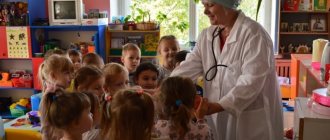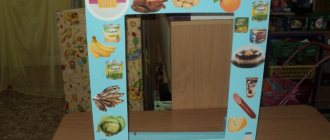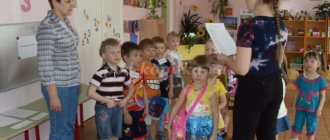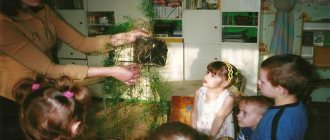Plot-role-playing game for preschoolers. article (senior group) on the topic
The structure of a plot-role-playing game.
A role-playing game has the following structural components: - plot;
- content;
— role [17].
Let's look at each of these structural components.
A) The plot of the game.
The main component of a role-playing game is the plot; without it, there is no role-playing game itself.
The plot is the sphere of reality that is reproduced by children. The plot is a child’s reflection of certain actions, events, relationships from the life and activities of those around him. At the same time, his playful actions (turning the steering wheel of a car, preparing lunch, teaching students how to draw, etc.) are one of the main means of realizing the plot.
The plots of the games are varied. They are conventionally divided into:
- household (family games, kindergarten);
- production ones, reflecting the professional work of people (games of hospital, store, livestock farm);
- public (games to celebrate the city’s birthday, to the library, to school, to fly to the moon) [8].
B) Game content. Changes in content depending on the age of the children.
The content of the game, notes D.B. Elkonin, is what is reproduced by the child as a central and characteristic moment of activity and relationships between adults in their everyday, work, and social activities [6].
Depending on the depth of the child’s ideas about the activities of adults, the content of the games also changes.
In terms of content, the games of children of primary preschool age differ from the games of older children. These differences are associated with the relative limitations of experience, features of the development of imagination, thinking, and speech. The child cannot imagine the game before it starts and does not grasp the logical sequence between real events [7]. Therefore, the content of the games, as A.P. Usova noted, is fragmentary and illogical. Children often repeat in play actions with toys shown by adults and related to everyday life: fed the bear - put him to bed; fed him again and put him to bed again. A.P. Usova characterized such games as action games [17].
However, at the border between the third and fourth years of life, games become more meaningful, which is associated with the expansion of children’s ideas about the world around them. Preschoolers begin to combine different events, including in games episodes from their own experience and from literary works that were read to them or, which is especially valuable, shown through plot-didactic games, illustrations in books, table theater, and filmstrips.
In the fourth and fifth years of life, the integrity of the plot and the interconnectedness of the reflected events are observed in children’s games. Preschoolers develop an interest in certain scenes that they have played with before (family, hospital, construction workers, transport, etc.). Children respond vividly to new experiences, weaving them like storylines into familiar games. The enrichment of content is facilitated by the interaction of children in the game, when everyone contributes something of their own, individual.
Children of senior preschool age thoughtfully approach the choice of plot, discuss it in advance, and plan the development of the content at an elementary level. New stories are appearing that are inspired by impressions gleaned outside the preschool: based on animated series, books read at home, stories from parents, etc.
In older and preschool age, generalization of play situations continues; in addition to conditional and symbolic actions (put his head on his palm - he fell asleep), children actively use verbal comments (“Everyone seems to have slept - and we’ll immediately go to the hall for the holiday!”; “Let’s do this: we’ve already arrived in Africa!”). These speech comments are a verbal replacement of any events [2]. Children resort to them so as not to violate the logic of the unfolding of the game’s content.
Thus, throughout preschool childhood, the development and complication of the content of the game is carried out in the following directions [1]:
- strengthening the purposefulness, and therefore the consistency and coherence of what is depicted;
- a gradual transition from an expanded game situation to a collapsed one, generalization of what is depicted in the game (the use of conditional and symbolic actions, verbal substitutions).
The variety of content of role-playing games is determined by children’s knowledge of those aspects of reality that are depicted in the game, the consonance of this knowledge with the interests, feelings of the child, and his personal experience. Finally, the development of the content of games depends on the child’s ability to identify characteristic features in the activities and relationships of adults.
B) Role in the game. Role changes as children age.
The content of the role-playing game is embodied by the child through the role he takes on. A role is a means of realizing the plot and the main component of a role-playing game [8].
For a child, a role is his playing position: he identifies himself with a character in the plot and acts in accordance with his ideas about this character. Every role contains its own rules of behavior, taken by the child from the surrounding life, borrowed from relationships in the adult world. Submission of the child to the rules of role-playing behavior is the most important element of role-playing play. Deviation of any of the players from these rules causes protests from the playing partners. Thus, for preschoolers, a role is an example of how to act. Based on this sample, the child evaluates the behavior of the participants in the game, and then his own.
Throughout preschool childhood, the development of role in role-playing games occurs from the performance of role-playing actions to role-images. For younger preschoolers, everyday activities predominate: cooking, bathing, washing, driving, etc. Then role designations associated with certain actions appear: I am a mother, I am a driver, I am a doctor.
In middle preschool age, playing a role becomes a significant motive for play activity: the child develops a desire not just to play, but to fulfill one or another role. The point of the game for a 4-5 year old preschooler is the relationships between the characters. Therefore, the child willingly takes on those roles in which the relationships are clear to him (the teacher takes care of the children, the captain steers the ship, makes sure that the sailors work well and that the passengers are comfortable). At this age, role speech becomes a means of interaction.
In older preschool age, the meaning of the game lies in the typical relationships of the person whose role is played by the child with other persons whose roles are taken on by other children. In games, role-playing dialogues appear, with the help of which the relationships between characters are expressed and game interaction is established. For the quality of role performance, the child’s attitude towards it is important. Therefore, it should be borne in mind that older preschoolers are reluctant to perform roles that, in their opinion, do not correspond to their gender. When performing a role, the child takes into account not so much the external logic, the sequence of actions (there is a free runway at the airfield, which means the plane can land), but the meaning of social relations (the runway is free, but you need to ask the dispatcher so that an accident does not happen).
Used Books .
1. Boychenko HA et al. Role-playing games for preschoolers. - Kyiv: Radyanska School, 1982.
2. Valitova I.E. Psychology of development of a preschool child. -Minsk, 1997
3. Zaporozhets A.V., Elkonin D.B. Psychology of preschool children. - M.: Mysl, 1989.
4. Zvorygina E.V. The first story-based games for kids. - M.: Radug
5.Kozlova S.A. Preschool pedagogy: a textbook for students / S.A. Kozlova, T.A. Kulikova. - M.: Publishing House, 2007. a, 1988.
6.Psychology and pedagogy of preschooler play. // Ed. A.V.Zaporozhets, A.P.Usova. - M.: Mysl, 1986.
How are role-playing games beneficial for a child’s development?
The benefits of such activities are varied. They are as follows:
- creating communicative and speech experience;
- enable the child to act in conditions reminiscent of real situations;
- opening up the chance for exploration and experimentation;
- help to gain social skills from communicating with children and adults;
- by trying on an unusual role, the baby will better understand those around him;
- promote knowledge of different cultures, expression of thoughts and feelings in the most friendly atmosphere;
- provide an opportunity to learn better through entertainment;
- stimulate imagination and creative skills.
Role-playing games are one of the effective language learning techniques. During the course, the baby copies the phrases he hears and can also form his own sentences. This technique promotes the development of vocabulary and experience of communicating with other people.
Types and examples of children's entertainment
Role-playing games are one of the important components of children's development. Activities like these help stimulate better imagination. Pretense or artistic play becomes a significant component of children's development.
“Mothers and daughters” and other emotionally charged activities
With the help of such entertainment, a child can form a clear social model of behavior in a team. For example, instill in girls the maternal instinct and mechanisms for handling the future newborn. In addition, the event helps to develop communication experience to the fullest.
In the same category are emotional games that evoke experiences that are not yet available: raising children, adult family relationships. It is worth showing the kids your own example: pick up a doll, kiss it, then lull it to sleep. My daughter will quickly learn to repeat such actions. It is useful for the smallest babies to demonstrate body parts on the baby doll.
“School”, “hospital”, “shop”, other situational actions
These activities are often accompanied by the use of special props: toy cash registers, money, doctor’s kits. In addition to modeling behavior and forming reactions to different formats of situations, an understanding of the functionality of additional props is developing. While playing with your baby, adults need to be shown how to count money correctly. For example, teach how much is fifty and ten, what “money” the buyer needs to return as change.
"Behavior Rehearsal"
This event is a simulation of an incident or an imaginary situation, the repeated experience of which will help to gain some experience in the game. “Rehearse” your child’s upcoming birthday, remembering the mistakes of the past holiday. You can imagine a “mock zoo” after returning from a real event. Such pastime allows you to get rid of psychological stress, it is often used to cause “re-experiencing” both positive and negative emotions. After this, it is easier to analyze the events and help the baby overcome stress (during the course of this game, it is advisable to ask the baby leading questions).
When a child is scared by an animal at the zoo, then re-experiencing a similar situation with a rubber animal will help get rid of the fear. For small children, repeating certain activities is suitable: rocking the child, turning the steering wheel. Help your baby and set an example by doing it several times to reinforce it.
Theater and masquerade
One of the most favorite games for children is stage dressing. This is explained not only by the inclusion of adults in the entertainment, but also by the approach of a favorite holiday (birthday, New Year, May Day). A costume performance will help you fully “fit into” the role, as well as gain admiration from your surroundings, as well as a feeling of “anonymity.” This will rid the baby of phobias and complexes, he will be more relaxed, since he is wearing a mask and no one will be able to recognize him.
Role-playing games are important in the development of children - they form a significant part of training and upbringing. Such events help to better strengthen the imagination and practice various skills. Children enjoy learning about the world through fun because communication allows them to exchange ideas. Through such games, the baby imagines himself in the future.




